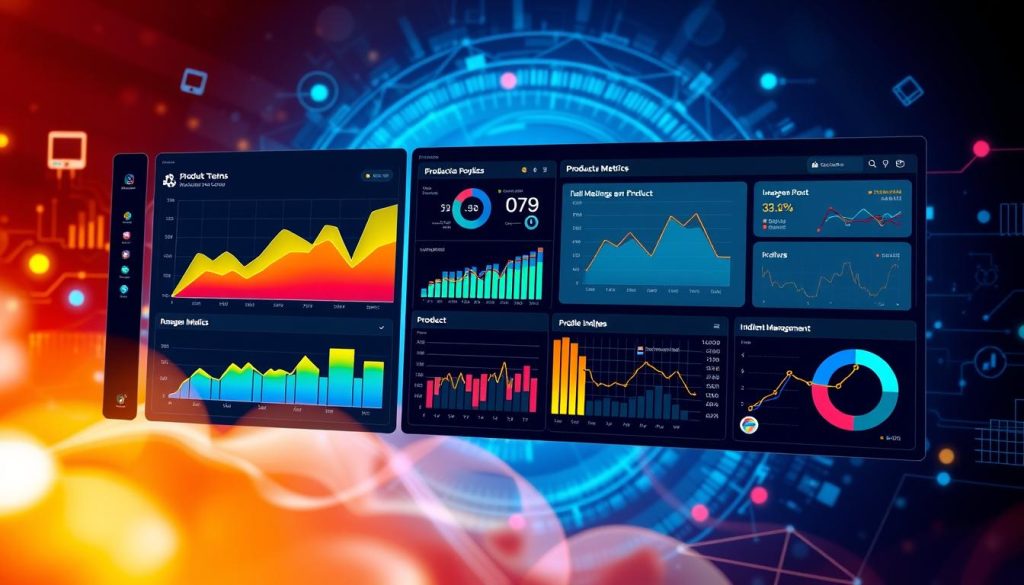Companies must stay ahead to keep their edge in today’s fast-paced business world. Product monitoring tools offer real-time insights into performance, user behavior, and market trends. These powerful software solutions help businesses make smart, data-driven choices.
These tools track various metrics, from software quality to user experience. They help teams quickly spot and fix issues. This ensures products meet the changing needs of their target audience.
By using these tools in DevOps, companies can improve their processes. They can also create a culture of ongoing improvement. This approach helps businesses stay competitive in the dynamic market.
Key Takeaways
- Product monitoring tools provide real-time insights into product performance, user behavior, and market trends.
- These solutions enable businesses to make data-driven decisions to optimize their offerings and enhance the customer experience.
- Comprehensive product monitoring tools track a wide range of metrics, from software quality assurance to user experience monitoring.
- Integrating product monitoring tools into DevOps workflows can streamline development processes and promote a culture of continuous improvement.
- Leveraging product monitoring tools is crucial for staying ahead of the competition in today’s dynamic business landscape.
Introduction to Product Monitoring Tools
Product monitoring tools are crucial for businesses in today’s fast-paced world. These software applications track and analyze product performance, usage, and trends. Companies use these tools to gain insights, improve quality, and enhance user experience.
What Are Product Monitoring Tools?
Product monitoring tools are software solutions that provide data on a company’s products or services. They track metrics like user engagement, feature use, and application performance. This data helps businesses improve offerings and make smart decisions.
Why Are They Important for Businesses?
Product monitoring tools are vital for businesses. They help with software quality assurance and application performance monitoring. These tools show how products perform in real-world situations.
Companies can use these insights to fix issues quickly and improve user experience. They can also adjust features based on customer feedback and usage patterns. Monitoring tools help prevent problems and guide product planning.
- Quickly identify and resolve issues or bugs, ensuring a seamless user experience
- Optimize product features and functionality based on customer feedback and usage patterns
- Proactively monitor for potential problems and take preventive action to avoid service disruptions
- Make data-driven decisions to inform product roadmaps and strategic planning
Product monitoring tools help businesses stay competitive and meet customer needs. They enable companies to create great products that boost growth and customer loyalty.
Key Features of Effective Product Monitoring Tools
Modern businesses use product monitoring tools to gain insights into their products and customer interactions. These tools have features that allow for thorough tracking and analysis. Let’s explore the key capabilities of effective product monitoring tools.
- Real-time Data Analysis: The ability to collect, interpret, and visualize real-time data on product performance, user behavior, and customer engagement.
- User Experience Monitoring: Tools that track user interactions, identify pain points, and provide insights to enhance the overall user experience.
- Application Performance Monitoring: Functionality to monitor application performance, identify bottlenecks, and optimize load times and response times.
- Error Tracking and Log Analysis: Comprehensive error reporting and log analysis capabilities to quickly identify and resolve issues.
- Software Quality Assurance: Features that support testing, compliance, and security to ensure the ongoing quality and reliability of the product.
These features work together to give businesses a complete view of their product’s performance. They help companies make data-driven decisions and improve user experience continuously.
| Feature | Description |
|---|---|
| Real-time Data Analysis | Collect, interpret, and visualize real-time data on product performance, user behavior, and customer engagement. |
| User Experience Monitoring | Track user interactions, identify pain points, and provide insights to enhance the overall user experience. |
| Application Performance Monitoring | Monitor application performance, identify bottlenecks, and optimize load times and response times. |
| Error Tracking and Log Analysis | Comprehensive error reporting and log analysis capabilities to quickly identify and resolve issues. |
| Software Quality Assurance | Features that support testing, compliance, and security to ensure the ongoing quality and reliability of the product. |
Using these key features helps businesses monitor their products effectively. They can improve performance, enhance user experience, and maintain high quality standards.
“Effective product monitoring tools are essential for businesses seeking to stay ahead of the curve and deliver exceptional products and services.”
Software Quality Assurance with Product Monitoring
Product monitoring tools are vital for software quality assurance. They help find and fix bugs quickly. These tools also maintain compliance and security standards in organizations.
Identifying and Resolving Bugs
Product monitoring tools give real-time insights into app performance. This helps teams spot and fix issues fast. They track user actions, error reports, and system logs.
These tools can find the cause of problems quickly. This prevents bigger disruptions in the software.
Ensuring Compliance and Security
Compliance and security are top priorities for businesses today. Product monitoring tools help companies stay safe and follow rules.
They check apps for weak spots and policy breaches. Alerts and detailed reports help teams protect systems and data.
| Feature | Benefit |
|---|---|
| Bug detection and resolution | Identify and fix issues quickly, preventing larger-scale disruptions |
| Compliance and security monitoring | Maintain regulatory standards and protect against cyber threats |
| Reporting and analytics | Gain valuable insights to drive continuous improvement |
Product monitoring tools boost software quality assurance. They make apps strong, safe, and compliant. This builds trust and reduces risks.
Companies can succeed in today’s changing business world with these tools.

Application Performance Monitoring
APM tools track and optimize user experience in product monitoring. They offer insights into user interactions, load times, and response times. Teams can identify and fix performance issues that affect product delivery.
Tracking User Experience
APM tools monitor user activities, session data, and engagement metrics. Businesses can understand how customers use their applications. This data helps improve the overall user experience.
Optimizing Load Times and Response Times
Users expect fast load times and instant responses in today’s digital world. APM features help organizations spot and fix performance issues quickly. This ensures applications run smoothly and efficiently.
Optimizing load and response times creates a positive user experience. This leads to increased customer satisfaction and loyalty.
| Metric | Benchmark | Impact |
|---|---|---|
| Load Time | Less than 3 seconds | Longer load times can lead to increased bounce rates and decreased user engagement. |
| Response Time | Less than 2 seconds | Slow response times can frustrate users and undermine the overall user experience. |
Product monitoring tools with APM capabilities offer valuable insights into application performance. Businesses can use this data to improve user experience and stay competitive.
Error Tracking and Log Analysis
Powerful product monitoring tools include error tracking and log analysis features. These help teams quickly spot and fix issues affecting their products. Such tools provide detailed information on errors and system events.
Error tracking helps teams capture and group errors and anomalies. This makes finding the root cause easier. Teams can create reports, see trends, and prioritize fixes based on severity.
Log analysis tools offer a full view of system activity. They help uncover hidden problems and boost performance. These features are crucial for improving product reliability.
| Feature | Benefit |
|---|---|
| Error Tracking | Quickly identify and resolve issues impacting product or service |
| Log Analysis | Gain deeper insights into system performance and uncover hidden problems |
Using product monitoring tools with strong error tracking and log analysis is key. Teams can address issues proactively and improve user experience. These tools are vital for long-term product success and stability.
“Effective error tracking and log analysis are essential for maintaining the health and reliability of our products. These tools provide the visibility and insights we need to quickly identify and resolve issues, ensuring a seamless experience for our customers.”
Uptime Monitoring and Incident Management
Product monitoring tools offer vital uptime monitoring and incident management features. These tools help prevent downtime and service disruptions. They also enable quick responses and thorough root cause analysis when issues occur.
Preventing Downtime and Service Disruptions
Uptime monitoring features detect potential outages or performance issues. They alert teams in real-time, allowing quick action. This proactive approach minimizes impact on users and ensures reliable product performance.
Rapid Response and Root Cause Analysis
Incident management tools help teams respond swiftly to service disruptions. They provide a central hub for logging, triaging, and resolving issues. These features empower teams to identify root causes quickly.
| Feature | Benefit |
|---|---|
| Uptime Monitoring | Proactive detection and alerting of potential outages |
| Incident Management | Streamlined incident logging, triage, and root cause analysis |
| Rapid Response | Minimized downtime and service disruptions |
“Effective product monitoring tools empower businesses to stay ahead of service disruptions and respond swiftly when issues do occur.”
Product monitoring tools help organizations maintain reliable and high-performing products. These tools ensure users consistently enjoy a positive experience. By using these features, businesses can protect their product’s quality.

Integrating Product Monitoring Tools into DevOps
Product monitoring tools are essential in modern DevOps practices. These tools offer real-time insights into product performance. They help teams make data-driven decisions throughout software development.
Quick issue identification is a major advantage of these tools. Teams can spot and fix bugs and performance problems faster. This ensures high-quality software delivery and improved user experience.
These tools also provide valuable data on user behavior. This information guides future product development and optimization. Teams can make smarter choices and create products that better serve customers.
Seamless Integration and Automation
Effective integration of product monitoring tools requires smooth connections with other DevOps processes. This involves linking monitoring data with tracking and collaboration tools.
Automating monitoring agent deployment is crucial. Integrating monitoring data into CI/CD pipelines is also important. These steps help teams make informed decisions and improve their processes.
- Connecting monitoring data with issue tracking and collaboration tools
- Automating the deployment of monitoring agents and configurations
- Integrating monitoring data into continuous integration and deployment pipelines
- Leveraging monitoring insights to inform decision-making and drive process improvements
This level of integration streamlines workflows and reduces manual effort. It makes product monitoring an essential part of development and operations.
| Key Capabilities | Benefits for DevOps |
|---|---|
| Real-time product performance monitoring | Proactive issue detection and resolution |
| Automated deployment and configuration | Reduced manual effort and increased efficiency |
| Integration with other DevOps tools | Improved collaboration and data-driven decision-making |
Product monitoring tools enhance software development and delivery processes. They help organizations create better products and stay competitive. These tools are key to successful DevOps implementation.
Product Monitoring Tools for Agile Development
Product monitoring tools are crucial in Agile development. They integrate with continuous processes, helping teams identify issues quickly. These tools foster collaboration and transparency throughout the product lifecycle.
Continuous Integration and Deployment
These tools support Agile practices like continuous integration and deployment. They provide real-time feedback on product performance, empowering teams to make improvements. This helps detect and fix bugs efficiently, ensuring a reliable user experience.
Collaboration and Transparency
Product monitoring tools boost collaboration among cross-functional teams. They offer a central platform for tracking metrics and sharing insights. This facilitates communication between developers, product managers, and stakeholders.
The transparency allows teams to make data-driven decisions. It helps deliver high-quality products that meet customer needs.
| Feature | Benefit |
|---|---|
| Continuous Monitoring | Provides real-time visibility into product performance, enabling quick response to issues |
| Error Tracking | Helps identify and resolve bugs faster, ensuring a smooth user experience |
| Collaboration Tools | Fosters cross-team collaboration and transparency, aligning stakeholders |
These tools help Agile teams stay ahead of the curve. They enable the delivery of high-quality products. Teams can improve their offerings to meet changing customer needs.
Choosing the Right Product Monitoring Solution
Finding the best product monitoring tool requires careful thought. Assess your needs, features, integration options, scalability, and pricing. This way, you’ll select a tool that matches your goals and budget.
Evaluating Your Needs
Define your business goals and challenges first. Think about your company’s size and product complexity. Consider the metrics and insights you need to track.
These factors will help you identify essential features for your chosen tool. Your needs will guide you toward the right solution.
Comparing Features and Pricing
Research the market for various product monitoring tools. Compare their features, integrations, and pricing structures. Look for tools with strong data analysis and real-time alerts.
Seek solutions offering customizable dashboards and smooth integration with your systems. These features will enhance your monitoring capabilities.
| Feature | Tool A | Tool B | Tool C |
|---|---|---|---|
| Real-time Monitoring | ✓ | ✓ | ✓ |
| Customizable Dashboards | ✓ | ✓ | – |
| Integrations with 3rd Party Tools | ✓ | – | ✓ |
| Pricing (per month) | $99 | $149 | $79 |
Thorough evaluation of your needs is crucial for choosing the right tool. Comparing features and pricing helps you make an informed decision. The right product monitoring tool will help track trends and optimize performance effectively.

Best Practices for Implementing Product Monitoring
Implementing product monitoring tools requires a smart approach. By following best practices, companies can get the most out of these tools.
Define clear objectives for your monitoring process. Set up data-driven KPIs that match your business goals. This will help measure how well your product monitoring tools are working.
Train your team members to use and understand monitoring data. Help them use insights from product monitoring tools to make smart choices.
Regularly review and refine your monitoring processes. This keeps them up-to-date with changing business needs. It also helps you stay ahead and make the most of your product monitoring tools.
Using these implementation best practices can give your business an edge. It unlocks the full power of product monitoring tools in the market.
| Best Practice | Description |
|---|---|
| Define Clear Objectives | Establish data-driven KPIs that align with your business goals. |
| Train Team Members | Empower employees to leverage insights from product monitoring tools. |
| Continuous Optimization | Regularly review and refine your monitoring processes to adapt to changing needs. |
“Successful implementation of product monitoring tools is crucial for businesses to gain a competitive edge in the market.”
Future of Product Monitoring Tools
Product monitoring tools are changing to meet new business needs. They’re becoming more important as companies grow and change. These tools will soon use new tech to help businesses work better.
Emerging Trends and Technologies
AI and machine learning will shape future product monitoring tools. These tools will give better insights and predict problems before they happen. Data visuals will make it easier to understand information quickly.
This will help businesses make smart choices faster. Users can see patterns and act on them right away.
Adapting to Changing Business Needs
To stay useful, these tools must work with many types of software. This gives a full picture of how products are doing. They’ll also need to show info in real-time.
Quick updates will let companies respond to trends fast. They can fix customer issues promptly too.
Product monitoring tools will help businesses stay ahead. They’ll use new tech to meet changing needs. These tools will boost innovation and help products succeed in the market.
Conclusion
Product monitoring tools are vital for businesses of all sizes. They provide crucial data and insights for informed decision-making. These tools help enhance product quality and deliver exceptional user experiences.
These solutions offer comprehensive capabilities for various aspects of product management. They cover software quality assurance, application performance monitoring, and error tracking. Uptime management is also a key feature.
Integrating these tools into DevOps workflows promotes collaboration and transparency. This leads to better products and satisfied customers. Businesses can optimize operations, reduce risks, and drive continuous improvement.
The product monitoring landscape is evolving with new trends and technologies. Companies must stay adaptable and choose the right solutions. Implementing best practices and refining strategies is crucial.
Product monitoring tools play a critical role in business success. Staying informed and proactive in this field is essential. By leveraging these tools effectively, organizations can navigate challenges and seize opportunities.




